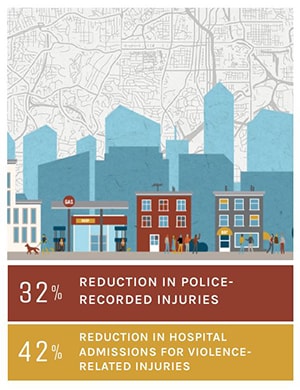What is the Cardiff Violence Prevention Model?
More than half of violent crime in the United States is not reported to law enforcement, according to the U.S. Department of Justice. That means cities and communities lack a complete understanding of where violence occurs, which limits the ability to develop successful solutions.
The Cardiff Violence Prevention Model provides a way for communities to gain a clearer picture about where violence is occurring by combining and mapping both hospital and police data on violence. But more than just an approach to map and understand violence, the Cardiff Model provides a straightforward framework for hospitals, law enforcement agencies, public health agencies, community groups, and others interested in violence prevention to work together and develop collaborative violence prevention strategies.
How does it work?
The Cardiff Model is a multi-agency approach to violence prevention that relies on the strategic use of information from health and law enforcement organizations to improve policing and community violence prevention programs.1 The basis of the model is information sharing. In healthcare settings, violence-related injury data including location, time, date, and mechanism of injury are collected. These data are combined with information from law enforcement to help communities map where violence frequently occurs. No other personal information (i.e., name, date of birth, social security number) is collected, shared, or used. The community violence maps can be used to identify the specific locations where violence occurs in public spaces such as bars, street corners, or subway stations.
The Cardiff Model relies on sustained partnerships between healthcare, law enforcement, public health agencies, other government agencies, and community organizations. The partnership uses local data to create effective injury and violence prevention policy, educate community leaders about the need for changes in the places people work and live, and encourage business owners and residents to prevent violence by using evidence-based solutions.
The Cardiff Model was created by Dr. Jonathan Shepherd, a surgeon and professor at Cardiff University in Wales, United Kingdom. Dr. Shepherd frequently treated people who were injured through violence in his hospital’s emergency department. Through his research he discovered that only a fraction of these injuries treated in emergency departments were reported to law enforcement.
In 1996, Dr. Shepherd gathered healthcare providers, law enforcement leadership, and other community stakeholders to discuss the concept of data sharing and the development of violence prevention interventions. By 1998, the Cardiff Model became the primary approach for violence prevention across the United Kingdom. The model has helped to facilitate solutions to violence such as changes in the environment of violent places (increased street lighting and the creation of more pedestrian-friendly streets), policy change (switch from glass to plastic barware in taverns), and promotion of stronger community partnerships (increased programs partnering with clergy to assist violence prevention).

What Is the evidence that the Cardiff Model is effective for violence prevention?
Since its development in 1996, the Cardiff Model has shown that sharing anonymous data describing the location of violence, weapon use, assailants, and time of violence can allow local police to improve their strategies to prevent street violence. CDC collaborated with Dr. Shepherd to conduct a multi-year evaluation that compared violence outcomes in Cardiff, Wales to the experience in 14 similar cities. The results indicated a 32% reduction in police-recorded injuries (comparable to aggravated assaults in the U.S.) and a 42% reduction in hospital admissions for violence-related injuries. The model saved over $19 in criminal justice costs and nearly $15 in health system costs for every $1 spent.